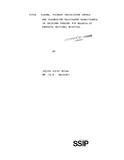| dc.contributor.author | Ngira, Julius | |
| dc.date.accessioned | 2013-05-25T11:29:28Z | |
| dc.date.available | 2013-05-25T11:29:28Z | |
| dc.date.issued | 1985 | |
| dc.identifier.citation | Master of medicine,University of Nairobi,1985. | en |
| dc.identifier.uri | http://erepository.uonbi.ac.ke:8080/xmlui/handle/11295/25715 | |
| dc.description.abstract | Between June 1984 and February 1985, 32 patients
with Plasmodium falciparum malaria were studied.
They were aged between 3 months - 12 years. The
clinical response, parasitaemia levels, plasma
and urinary chloroquine levels, and in vivo and
in vitro chloroquine sensitivity were determined.
The parasite counts ranged from 39/300 w.b.c. -
9,630/300 w.b.c. On the third day 21(66%) of the
patients showed clinical cure (i.e. symptomatic
relief without necessarily having parasite clearance).
Of these 6(19%) had cleared their parasites on
chloroquine therapy, while 15(48%) were asymptomatic
but still had parasitaemia. One patient was
dropped from parasitaemia analysis because of
incomplete counts. The other 10(32%) patients
still had clinical malaria and parasitaemia on
day 3.
Persisting symptoms on both days 3 and 7 were
fever and vomiting in 10(32%) patients and 8(26%)
patients respectively. They had associated
parasitaemia.
A total of 13(42%) patients cleared on chloroquine
during the study. The average clearance time on
chloroquine was 5 days. The other 18(58%)
patients failed to clear. Of these 10(32%)
had their treatment changed on day 3 based on
clinical and parasitological grounds. In the
remaining 8(26%) patients treatment was changed
between day 7 and 28 of follow up.They all had
clinical malaria.
The pattern of in vivo response was: Sensitive
(S) - 13(42~ ; Resistant (R) at RI 4(13%);
Rll 8(26%) and RIll 6(19%).
There was therapeutic plasma chloroquine levels
pretreatment in 19/22 (86%) of samples analyzed.
One of these had toxic levels of 0.7467 ug/ml.
More patients attained toxic levels following
administration of chloroquine in the hospital
by the 2nd and 3rd day 8/22(36%). The therapeutic
range fur plasma chloroquine is 0.01ug/ml
-0.03ug/ml.The upper limit of tolerable level
was taken as O.4Wg/ml.
In vitro sensitivity tests by Rieckmann microtest
were successfully done in 19 cases. The
minimal Inhibitory Concentration (MIC) was
taken as 114nM/L (O.03648wg/ml). Of the isolates
3/19(16%) were sensitive in vitro. They were
also sensitive in vivo. The other 16/19(84%)
were resistant in vitro. Of these 7(37%) were
resistant at concentrations equal to or above
640nM/L (0.2048~g/ml). This was the highest
attainable concentration on the plates used.
There was disparity found between resistance in
vitro and resistance in vivo. 6(32%) isolates
were resistant in vitro but sensitive in vivo.
Their MIC was mostly 640nM/L(0.2048~g/ml)
and over. All resistant in vivo cases,were also
resistant in vitro.
Urinary chloroquine assays showed 10/12 (63%)
of samples analyzed had detectable chloroquine
pretreatment.
There was no correlation between plasma chloroquine
levels and parasite clearance by day 3.
All patients were from rural areas and were
visiting Nairobi. Resistance in vivo and in vitro
was demonstrated from Eastern, Nyanza, Western
and Central provinces. There are pockets of
resistant P. falciparum strains in endemic areas
in Kenya as has been demonstrated at the coast
and Kisumu in previous studies and now in Eastern
Province in this study. | en |
| dc.language.iso | en | en |
| dc.publisher | University of Nairobi | en |
| dc.title | Plasma, urinary chloroquine levels and plasmodium falciparum parasitaemia in children treated for malaria at Kenyatta National Hospital. | en |
| dc.type | Thesis | en |
| dc.description.department | a
Department of Psychiatry, University of Nairobi, ; bDepartment of Mental Health, School of Medicine,
Moi University, Eldoret, Kenya | |
| local.publisher | medicine | en |

